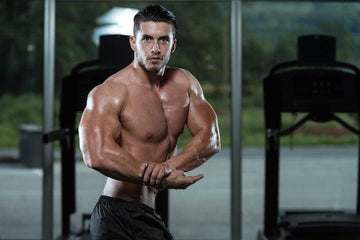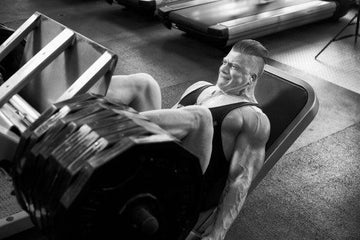

Mind Muscle Control for Muscle Growth: Reality or Complete BS?
Table of Contents
Mind Muscle Control for Muscle Growth: Reality or Complete BS.
By: Robbie Durand
If you have ever watched the classic bodybuilding movie, “Pumping Iron”, Arnold mentions that he would visualize the muscle growing. There are many bodybuilders that have preached that you must concentrate on the muscle while lifting instead of throwing heavy weight around. So there are those in the heavy weight club that focus on lifting heavy weight whereas there are others that believe in using a slow and controlled lifting pattern and focus on the squeezing the muscle. In the latest issue of the Strength and Conditioning Journal, Dr. Schoenfeld and Contreras wrote and interesting article titled, “Attentional Focus for Maximizing Muscle Development: The Mind-Muscle Connection.” The article describes in detail the scientific validity for mind-muscle training and how bodybuilders should start utilizing these principles.
If you don’t believe in the mind-muscle connection, here are a few studies that may change your mind.
Study #1
 Researchers had 25 subjects performed sit-ups exercises in accordance with 3 different sets of instructions: nonspecific instructions (NS), instructions intended to emphasize rectus abdominis activity (abs), and instructions intended to emphasize oblique abdominis activity (OE). EMG activity was recorded from the upper and lower rectus and the internal and external oblique abdominis muscles while a physical target was used to insure that the trunk was raised to the same height for all conditions. The researchers found that subjects were able to significantly alter the muscle activity to either the rectus abdominis or obliques by consciously focusing on the respective muscles during performance of the sit up. This means when the subject’s focused on contracting the muscle, they were able to increase the muscle activation of the muscle.
Researchers had 25 subjects performed sit-ups exercises in accordance with 3 different sets of instructions: nonspecific instructions (NS), instructions intended to emphasize rectus abdominis activity (abs), and instructions intended to emphasize oblique abdominis activity (OE). EMG activity was recorded from the upper and lower rectus and the internal and external oblique abdominis muscles while a physical target was used to insure that the trunk was raised to the same height for all conditions. The researchers found that subjects were able to significantly alter the muscle activity to either the rectus abdominis or obliques by consciously focusing on the respective muscles during performance of the sit up. This means when the subject’s focused on contracting the muscle, they were able to increase the muscle activation of the muscle.
Study #2
To investigate whether women use a consistent and distinguishable muscle activation order when extending the hip while prone and to explore the effects of verbal cues on muscle activation and movement. Eleven healthy women were tested under 3 conditions: no cues, cues to contract the gluteal muscles, and cues to contract the hamstrings muscles. At the end of the study, the researchers showed that young women were able to achieve greater mean EMG activity of the gluteus maximus and reduced activation of the hamstrings when cued to contract the gluteal muscles during performance of the prone hip extension. When compared with the no-cues condition, verbal cues to contract the gluteal muscles while lifting the leg resulted in nearly simultaneous contraction of the hamstrings and gluteus maximus, stronger activation of the gluteus maximus, and reduction of total knee flexion.
Study #3
A 2012 study found that activation of the pectorals was amplified by 22% when resistance-trained men were provided with verbal instructions to focus on the chest muscles during bench press at 50% 1 repetition maximum (1RM). However, the magnitude of this effect decreased to 13% when the same instructions were provided during performance at 80% 1RM. This may be a function of needing to exert greater levels of force when training at heavier loads, thereby altering one’s ability to focus on the muscle being worked.
So the takeaway message is that when your exercising a muscle, focus on squeezing the muscle. Based on the current research, it seems that actively focusing on the muscle and contracting it while performing a repetition will increase the muscle activation of the muscle and lead to greater muscle growth.
Karst GM and Willett GM. Effects of specific exercise instructions on abdominal muscle activity during trunk curl exercises. J Orthop Sports Phys Ther 34: 4–12, 2004.
Lewis CL and Sahrmann SA. Muscle activation and movement patterns during prone hip extension exercise in women. J Athl Train 44: 238–248, 2009.
Wakahara T, Fukutani A, Kawakami Y, and Yanai T. Nonuniform muscle hypertrophy: Its relation to muscle activation in training session. Med Sci Sports Exerc 45: 2158–2165, 2013.
Snyder BJ and Fry WR. Effect of verbal instruction on muscle activity during the bench press exercise. J Strength Cond Res 26: 2394–2400, 2012.
Snyder BJ and Leech JR. Voluntary increase in latissimus dorsi muscle activity during the lat pull-down following expert instruction. J Strength Cond Res 23: 2204–2209, 2009.
MUSCLE MEDIA MAGAZINE FOR MEN
The premier source of training, nutrition, supplements, fat loss and health for men.

















